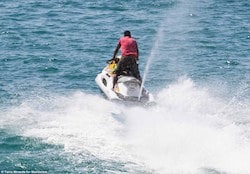Mexico’s famous tourist destination Acapulco has seen a disturbing trend in 2016: assassins using jet-skis to conduct mid-day murders on the beach, suggesting the city’s sky-high violence is increasingly affecting its tourism industry.
On January 29, an assassin swam to the beachfront of Acapulco Bay from his nearby jet-ski, 9mm pistol in hand, and shot a 46-year old beach vendor three times in the chest, reported Daily Mail. The murder, which occurred in broad daylight as sunbathing tourists looked on, is the fourth such “jet-ski assassination” in the tourist hotspot this year.
Following the shooting, the assassin swam back to his waiting jet-ski, which was being driven by an accomplice, and sped off down the coast. It took Mexican police an hour to respond to the attack, and over a month later the perpetrators have not been identified.
Extortion rings are known to operate in the area, demanding a 15 percent tax from the earnings of local businesses and street vendors, according to Daily Mail. While the motive for the killing is unclear, its brazen nature may have been a message to other businesses — pay up or die.
A local crime reporter told Daily Mail that 50 percent of murders in Acapulco are cartel related, and 30 percent are linked to extortion.
InSight Crime Analysis
Acapulco is in the midst of a crime wave, and finished 2015 with a homicide rate of 105 per 100,000 citizens, making it the most violent city in Mexico and the world’s fourth most violent city overall.
Competition among local criminal groups is driving this violence.
Acapulco sits within Mexico’s notoriously violent state of Guerrero, which is valuable real estate for criminal organizations. The state is a top producer of opium and methamphetamine, and is an important transit point for South American cocaine. Local criminal groups have also increasingly turned to extortion and kidnapping to generate revenue, and some Acapulco businesses complain they have to pay extortion fees to multiple gangs.
SEE ALSO: Mexico News and Profiles
Previously, however, Acapulco’s criminal violence has been largely contained to the city’s periphery. But, as these “jet-ski assassinations” suggest, it is now increasingly affecting its traditionally safer tourist center.
According to the BBC, tourism has been estimated to form as much as 80 percent of Guerrero’s economy. If continued violence in Acapulco significantly affects the local tourism industry by dissuading visitors it could have disastrous effects on the region’s economy, robbing residents of legitimate livelihoods and potentially giving rise to even more violence.

